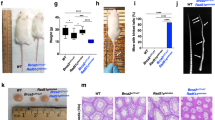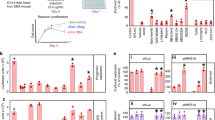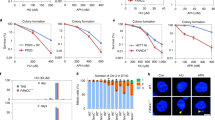Abstract
The Fanconi anemia and BRCA networks are considered interconnected, as BRCA2 gene defects have been discovered in individuals with Fanconi anemia subtype D1. Here we show that a defect in the BRCA2-interacting protein PALB2 is associated with Fanconi anemia in an individual with a new subtype. PALB2-deficient cells showed hypersensitivity to cross-linking agents and lacked chromatin-bound BRCA2; these defects were corrected upon ectopic expression of PALB2 or by spontaneous reversion.
This is a preview of subscription content, access via your institution
Access options
Subscribe to this journal
Receive 12 print issues and online access
$209.00 per year
only $17.42 per issue
Buy this article
- Purchase on SpringerLink
- Instant access to full article PDF
Prices may be subject to local taxes which are calculated during checkout


Similar content being viewed by others
References
Levitus, M. et al. Cell Oncol. 28, 3–29 (2006).
Taniguchi, T. & D'Andrea, A.D. Blood 107, 4223–4233 (2006).
Howlett, N.G. et al. Science 297, 606–609 (2002).
Levitus, M. et al. Nat. Genet. 37, 934–935 (2005).
Xia, B. et al. Mol. Cell 22, 719–729 (2006).
Schouten, J.P. et al. Nucleic Acids Res. 30, e57 (2002).
Batzer, M.A. & Deininger, P.L. Nat. Rev. Genet. 3, 370–379 (2002).
Waisfisz, Q. et al. Nat. Genet. 22, 379–383 (1999).
Chang, M.W. Lymphat. Res. Biol. 1, 259–265 (2003).
Mueller, B.U. & Mulliken, J.B. Semin. Perinatol. 23, 332–340 (1999).
Alter, B.P. et al. J. Med. Genet. published online 20 October 2006 (doi:10.1136/jmg.2006.043257).
Lorenzo Bermejo, J. & Hemminki, K. Ann. Oncol. 15, 1834–1841 (2004).
Friedenson, B. MedGenMed 7, 60 (2005).
Acknowledgements
We thank the family of individual EUFA1341 for contributing to this study, M. Makiya and C. de Leon Lucero for help in the collection of clinical data and J. Steltenpool and A. Oostra for expert technical assistance. The members of the Livingston laboratory are grateful to A. D'Andrea and his colleagues at the Dana Farber Cancer Institute for a number of useful discussions and for Fanconi anemia-related reagents. This study was financially supported by the Netherlands Organization for Health Research and Development (J.P.d.W. and N.A.); by grants, including a breast cancer SPORE, from the National Cancer Institute (D.M.L.); by the Breast Cancer Program of US Army Medical Research and Materiel Command (B.X.); by the Intramural Research Program of the National Institute on Aging, US National Institutes of Health (W.W.) and by the Fanconi Anemia Research Fund (H.J.)
Author information
Authors and Affiliations
Corresponding authors
Ethics declarations
Competing interests
D.M.L is a scientific consultant to and recipient of a research grant from Novartis AG. A.E. is an employee of MRC-Holland BV.
Supplementary information
Supplementary Fig. 1
Deletion screening by MPLA. (PDF 98 kb)
Supplementary Fig. 2
Pedigree of EUFA1341 and cancer cases in the family. (PDF 77 kb)
Supplementary Table 1
Primer information. (PDF 104 kb)
Rights and permissions
About this article
Cite this article
Xia, B., Dorsman, J., Ameziane, N. et al. Fanconi anemia is associated with a defect in the BRCA2 partner PALB2. Nat Genet 39, 159–161 (2007). https://doi.org/10.1038/ng1942
Received:
Accepted:
Published:
Issue Date:
DOI: https://doi.org/10.1038/ng1942



